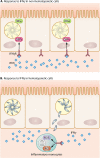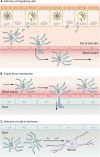Long-Term Relationships: the Complicated Interplay between the Host and the Developmental Stages of Toxoplasma gondii during Acute and Chronic Infections
- PMID: 26335719
- PMCID: PMC4557073
- DOI: 10.1128/MMBR.00027-15
Long-Term Relationships: the Complicated Interplay between the Host and the Developmental Stages of Toxoplasma gondii during Acute and Chronic Infections
Abstract
Toxoplasma gondii represents one of the most common parasitic infections in the world. The asexual cycle can occur within any warm-blooded animal, but the sexual cycle is restricted to the feline intestinal epithelium. T. gondii is acquired through consumption of tissue cysts in undercooked meat as well as food and water contaminated with oocysts. Once ingested, it differentiates into a rapidly replicating asexual form and disseminates throughout the body during acute infection. After stimulation of the host immune response, T. gondii differentiates into a slow-growing, asexual cyst form that is the hallmark of chronic infection. One-third of the human population is chronically infected with T. gondii cysts, which can reactivate and are especially dangerous to individuals with reduced immune surveillance. Serious complications can also occur in healthy individuals if infected with certain T. gondii strains or if infection is acquired congenitally. No drugs are available to clear the cyst form during the chronic stages of infection. This therapeutic gap is due in part to an incomplete understanding of both host and pathogen responses during the progression of T. gondii infection. While many individual aspects of T. gondii infection are well understood, viewing the interconnections between host and parasite during acute and chronic infection may lead to better approaches for future treatment. The aim of this review is to provide an overview of what is known and unknown about the complex relationship between the host and parasite during the progression of T. gondii infection, with the ultimate goal of bridging these events.
Copyright © 2015, American Society for Microbiology. All Rights Reserved.
Figures





References
-
- Lindsay DS, Dubey JP. 2014. Toxoplasmosis in wild and domestic animals, p 194-209. In Weiss LM, Kim K (ed), Toxoplasma gondii: the model apicomplexan, 2nd ed Elsevier, Amsterdam, The Netherlands.
-
- Cook AJ, Gilbert RE, Buffolano W, Zufferey J, Petersen E, Jenum PA, Foulon W, Semprini AE, Dunn DT. 2000. Sources of toxoplasma infection in pregnant women: European multicentre case-control study. European Research Network on Congenital Toxoplasmosis. BMJ 321:142–147. doi:10.1136/bmj.321.7254.42. - DOI - PMC - PubMed
Publication types
MeSH terms
Grants and funding
LinkOut - more resources
Full Text Sources
Medical
Miscellaneous

